
Aircraft acquisition is no small undertaking. It requires proper research, planning, and a keen understanding of the gravity of such a purchase. Proper aircraft acquisition planning, facilitated by Essex Aviation Group can make the process seamless and efficient.
Essex Aviation Group’s President & CEO Lee Rohde is an industry expert and sought-after aircraft acquisition advisor. He and the consultants at Essex Aviation Group have decades of aircraft acquisition planning experience. They have the expertise, so you can be informed rather than overwhelmed throughout your journey.
Prior to beginning your acquisition process, it is important to understand the various ownership structures available.
Primary Aircraft Acquisition Avenues
There are four popular means of aircraft utilization or acquisition – charter, fractional ownership, leasing, and outright aircraft purchase. Every method is largely dependent upon your needs but having a basic understanding will help you begin your initial research and analysis.
Chartering an aircraft is the ideal solution for users who fly less than 50 hours per year. This avenue eliminates maintenance and capital costs, limiting your fees strictly to aircraft usage. Issues can arise in terms of availability during high-demand periods, and tax benefits do not apply to charter aircraft users.
The second option, Fractional ownership is more appropriate for the mid-range users, those who fly between 50 and 100 hours per year. “Shares” or a percentage of an aircraft are sold to the owner and operated by the fraction program on their behalf for a fixed period, usually between three and five years. This improves your aircraft availability and allows you to collect certain tax benefits.
“Fractional ownership is a contained cost,” said Rohde. “However, at some point you may reach a point where you don’t want to share an airplane, or don’t want to fly on a different aircraft with a different crew every time.”
The third option, leasing a dedicated aircraft, has two options: wet and dry. Wet leasing refers to when the aircraft owner (lessor) provides the aircraft, crew, maintenance, and insurance to the lessee, who pays only for hours operated. The lessee pays for fuel, airport fees, and any other duties, taxes, etc. Wet lease terms usually run from one to 24 months. A dry lease requires that the lessor provide only the aircraft, while the lessee pays for insurance, crew, ground staff, supporting equipment, maintenance, and other costs. A typical dry lease runs two years or more.
While leasing had grown increasingly unpopular since the market downturn in 2008 due to the market values being well below the projected residual values that were set at the time of the lease, the recent tax law changes have made leases more popular again in the industry.
Outright purchases is the fourth option when acquiring an aircraft. This is the ideal ownership structure for those who will fly more than 150 hours in the year. Outright purchase requires the most acquisition planning, ideally with the assistance of an unbiased qualified aviation advisor who can assist with all aspects of the acquisition and various options available for the on-going operations and support of the aircraft.
“I tell a potential client that I am here to understand their travel needs,” said Rohde. “If you already have ownership experience, we review that. If you’re new to it, we talk to you about what’s out there, the options that can meet your needs, and the pros and cons. We look at it from the real-life operational perspective.”
Clients looking to purchase must consider new vs. used, management and staffing plans, financing, insurance, tax, and a legal consultation.
Aircraft Acquisition Financing, Insurance, & the Fine Print
Financing plans for the purchase of an aircraft should be established early in the acquisition process. It will absolutely require more than 30 days to obtain financing, so expecting a rushed turnaround from an aircraft lender will likely only leave you disappointed.
Most buyers these days pay cash for aircraft purchases, but if you require an aviation loan, many lenders are now pursuing these loans more aggressively. Experts recommend financing through a lender with whom you have already established a relationship. If your preferred lending establishment doesn’t finance aircraft, they can likely recommend one they work closely with.
Any bank will require title insurance, which protects all parties in a purchase against forgeries, fraud, and FAA filing or recording errors. Aside from an aviation advisor, it is essential to include an aviation attorney and tax counsel in your decision-making group.
Taxes and fees you will encounter during the process of ownership can be complex. The tax system for aircraft acquisition is largely differentiated based on location of sale, and location of domicile. The types of taxes to be aware of are:
- Sales tax – due in state in which the aircraft is delivered
- Use tax – due in the state in which the aircraft will primarily be domiciled
- Aircraft registration fees – due in the state in which the aircraft is domiciled
- Ad valorem/personal property taxes – due in the state in which the aircraft is domiciled
There is, however, a loophole you should be aware of. Flyaway exemption allows a non-resident buyer in a state where delivery is taking place to remove the aircraft from that state within a specific period of time and not pay sales tax.
Understanding your options is just the first step in what can be both an exciting yet nerve-wracking process. Now that you have the proper foundational knowledge, contact Essex Aviation Group to take the next step.






